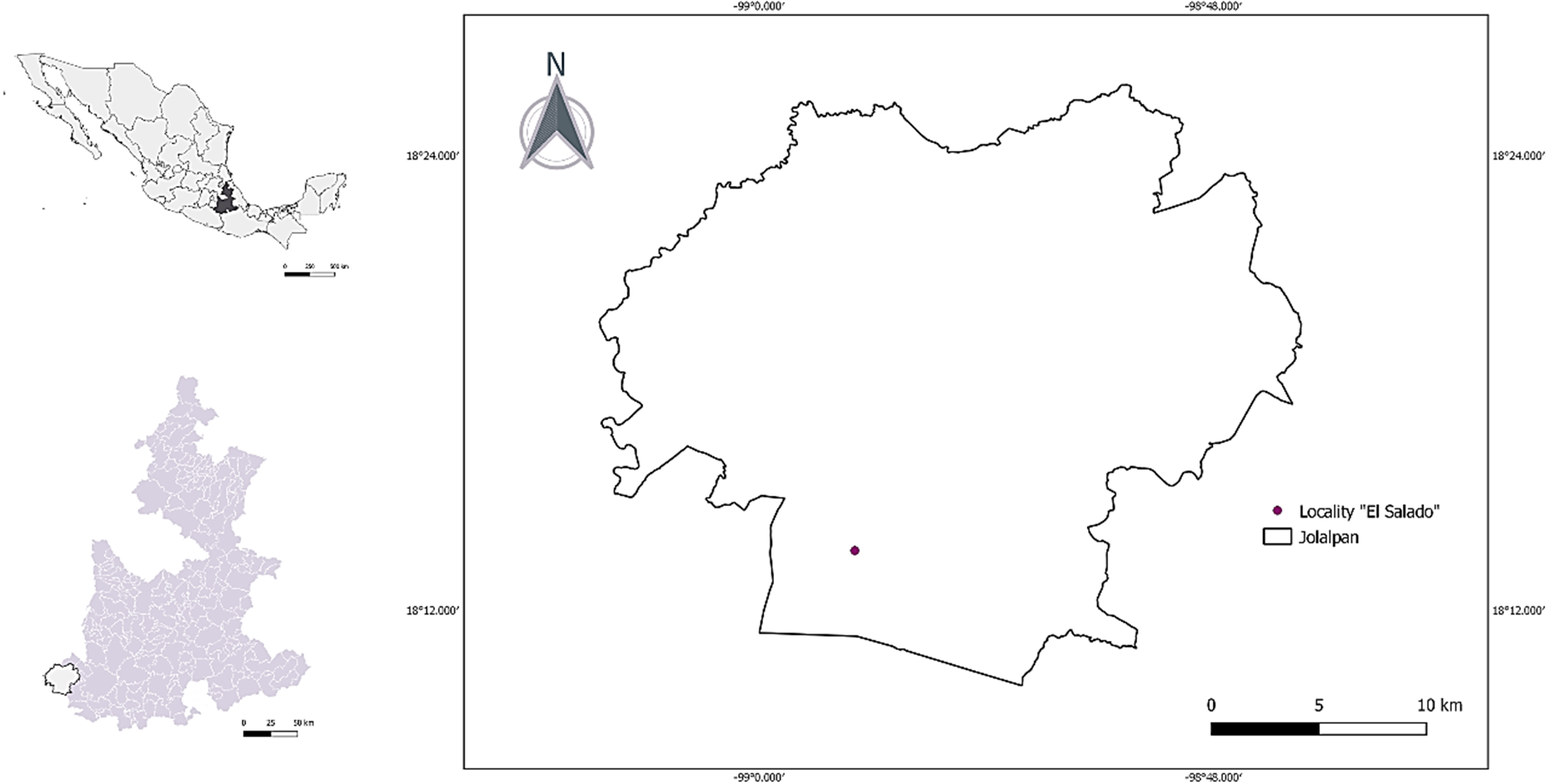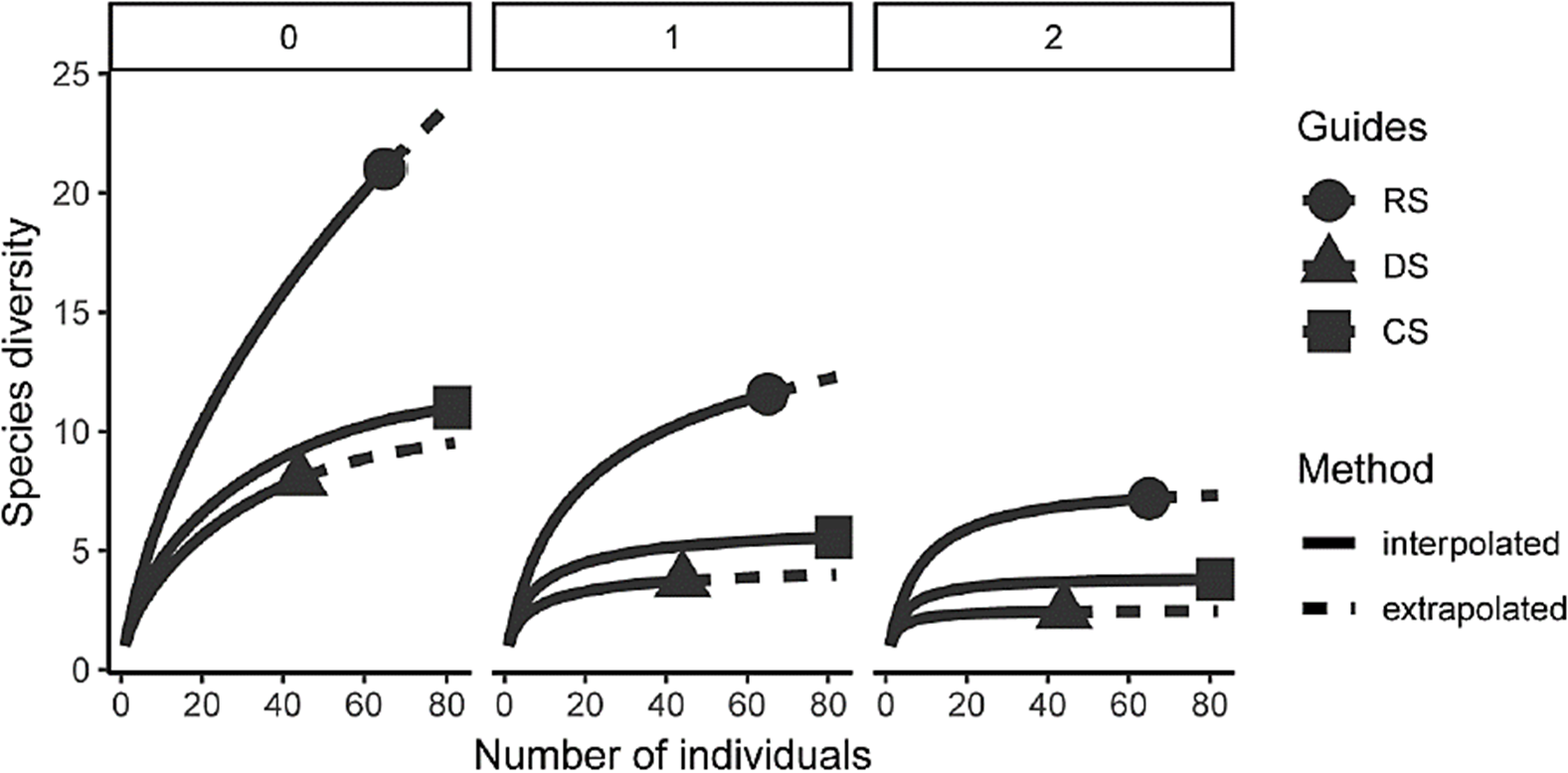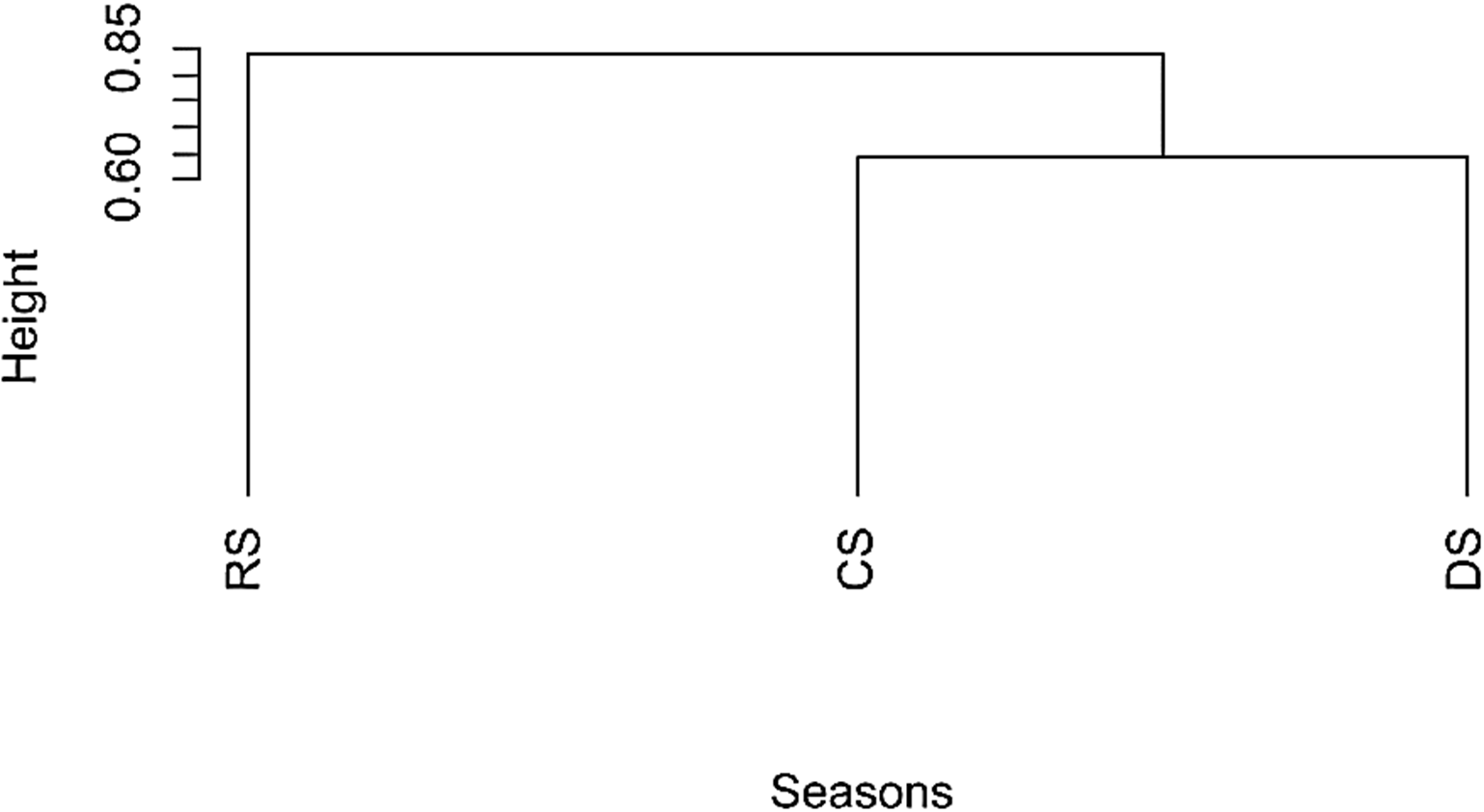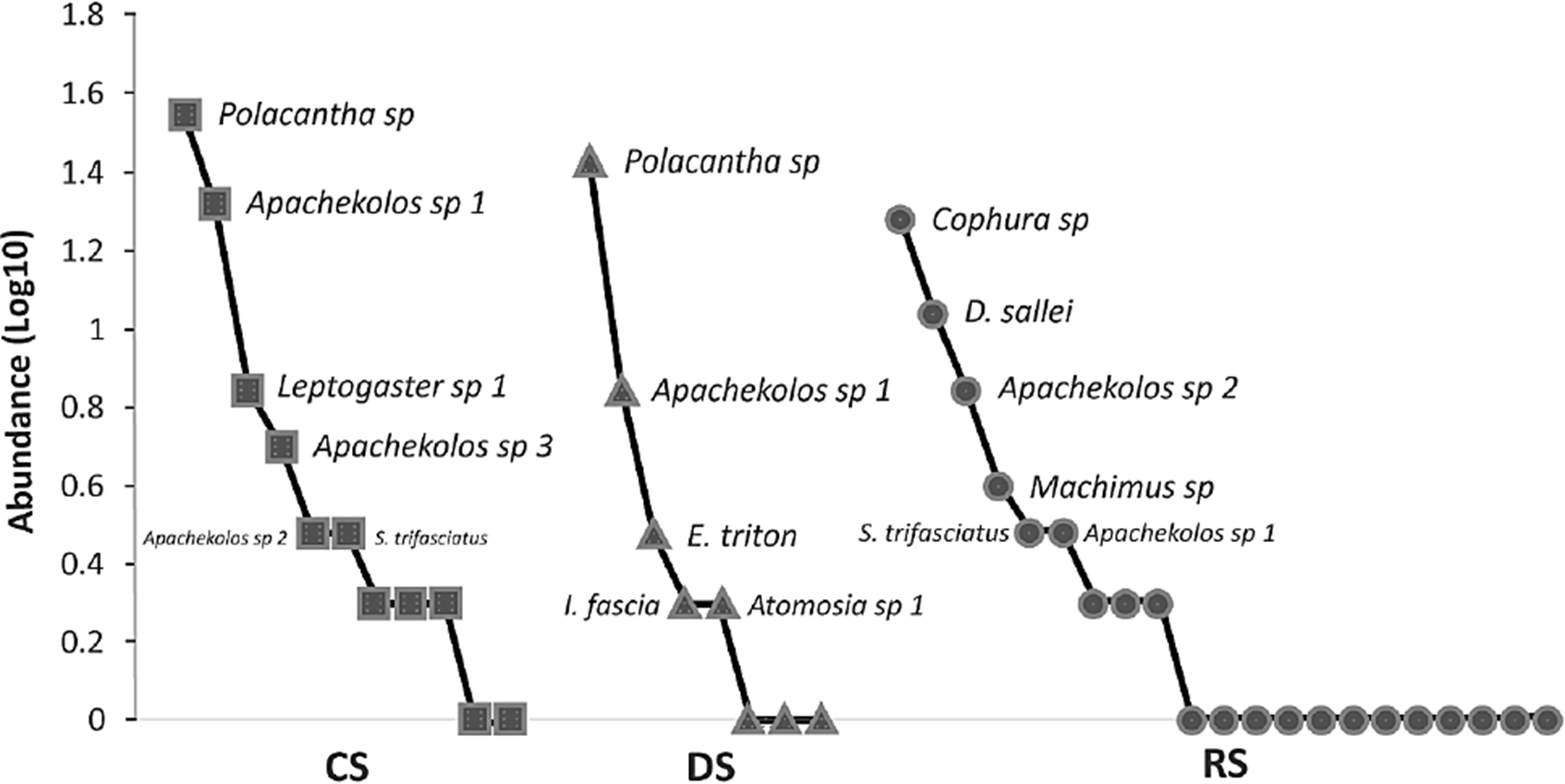INTRODUCTION
Asilidae is a family of predatory dipterans that feed on other arthropods, mainly insects. It is the third most diverse family in the order Diptera with approximately 7,500 described and validated species worldwide (Pape et al., 2011; Brown et al., 2018), of which, 481 species have been recorded in Mexico (Ibáñez-Bernal, 2017). Robber flies are found worldwide, but are more frequent in open areas (Wood, 1981), particularly in arid and semi-arid regions (Hull, 1962). Many robber flies exhibit high specificity for perching sites, and the size and type of prey they consume depends on the size of the robber fly (Shelly, 1985).
Given that robber flies predate on other insects, they contribute to maintaining a balance in insect populations (Hull, 1962). As a result of this, and of their habitat specialization, they are considered an important element within ecosystems (Barnes et al., 2007). However, this is not reflected in Asilidae studies in Mexico. There is a lack of information about their taxonomy, distribution, and, thus, about their species ecology.
Tropical deciduous forests have been reported to be important for diversity, species richness and abundance of some dipterans, including robber flies (Martin-Park et al., 2018). This type of vegetation covers close to 8% of Mexico’s surface (Rzedowski, 2006) and approximately 15.6% of the surface of the state of Puebla (Guevara-Romero, 2011). Tropical deciduous forests are characterized by a rainy season and by the loss of leaves during the dry season (Rzedowski, 2006). In other tropical zones, the abundance of robber flies has been reported to be higher during the rainy season compared to the dry season (Denlinger, 1980; Fisher & Hespenheide, 1982; Shelly, 1985; Martin-Park et al., 2018). This is probably related to a decrease in different insect taxa that serve as prey during the dry season in tropical zones (Wolda, 1978; Denlinger, 1980; Shelly, 1985). Nevertheless, this variation could also be an indication of the requirements of robber flies during the larval stages, which are not well known (Shelly, 1985).
Given that tropical deciduous forest exhibit contrasting biotic and abiotic changes between the dry and rainy seasons asilid communities that exist there could be affected. Therefore, in the present study, we describe and compare parameters from a robber fly community (diversity, richness, similarity, and abundance) in a tropical deciduous forest of the state of Puebla, Mexico to evaluate if the rainy season affects community structure. We also develop a checklist of robber flies from Jolalpan, Puebla.
MATERIALS AND METHODS
Study area. The study was carried out in “Rancho El Salado”, located in a locality of the same name, in the municipality of Jolalpan, in the southwest of the state of Puebla (18° 20’ 13’’ N and 98° 57’ 29’’ W) (Fig. 1). The site has an altitude of 920 m. The climate type is Aw (hot, sub-humid with many summer rainfalls and with less than 5% of winter rainfall) and mean annual temperature of 25.6°C. The main type of vegetation is tropical deciduous forest with human-induced grasslands and extensive agriculture (Martínez-Moreno et al., 2016).
Insect collecting method. Insects were collected during the cold (CS), dry (DS), and rainy (RS) seasons of the years 2015, 2016, and 2017. For each sampling, eight Malaise traps separated every 200 m, were used for three days. All the collected material was preserved in 96% alcohol.
Specimen preparation and identification procedures. Collected specimens were subjected to the method of mounting insects known as “critical point” (modified from Gordh and Hall, 1979), which consists in: Immersing the specimens in ethyl acetate, mounting them with an entomological pin, and exposing them to the light of an incandescent lamp in order to accelerate the process of dehydration and prevent their bodies from collapsing. The organisms that could not be identified to a specific level, due to a lack of taxonomic information, were classified as morphospecies (Krell, 2004). For subfamily classification, we follow Dikow (2009) except in the cases specified in Table 2 in which we use Geller-Grimm (2004) classification. All individuals were deposited in the Entomological Collection of the Laboratorio de Artropodología y Salud of the Benemérita Universidad Autónoma de Puebla.
Data analysis. To determine if there were variations in the structure of the robber fly community between the different seasons, we measured species richness, diversity, similarity, and abundance for each season.
Species richness and diversity
We calculated the effective number of species (Hill numbers) through the indexes q= 0 (species richness), q= 1 (common species) and q= 2 (dominant species) (Jost, 2006; Moreno et al., 2011). We also calculated the 84% confidence intervals (CI) as suggested by MacGregor-Fors and Payton (2013), to determine if there were significant differences between the cold, dry, and rainy seasons. Sample coverage was measured using curves based on rarefaction (interpolation) and extrapolation (Chao et al., 2014). These analyses were performed with the package iNEXT (Hsieh et al., 2016) in R 3.5.2 (R Core Team, 2018).
Similarity
We measured the similarity of the robber flies found in each season with the Jaccard index (Ij) and constructed a dendrogram to facilitate the comparison between seasons. These analyses were run using the Vegan package of R 3.5.2 (R Core Team, 2018).
Abundance
We measured abundance as the number of individuals per season. We also constructed a rank-abundance curve by transforming the data to log10 and performed an ANCOVA to determine if abundance varied significantly between seasons (Ortega-Álvarez & MacGregor-Fors, 2009).
Checklist
The inventory of species was built with the material collected in the cold, dry and rainy seasons from 2015 to 2017. We added material collected in two extra samplings carried out at the end of the rainy season of 2014 and 2015. Even though we used the same collecting method, these data could not be included in the analyses because they were obtained from only two years instead of three like the rest of the data. Nevertheless, we believe it was appropriate to include them in the listing of species and the discussion considering the relevance of our findings.
RESULTS
We collected a total of 191 individuals classified into eight nominal species and 21 morphospecies. Richness and diversity were higher during the rainy season (Table 1). Species composition in CS and DS was different from that in RS, although abundance was not significantly different between seasons.
Table 1 Species/morphospecies richness, diversity, and abundance of robber flies in Jolalpan, Puebla, Mexico, during three different seasons of 2015, 2016, and 2017.
| Species/morphospecies | CS | DS | RS | % of total | Total |
|---|---|---|---|---|---|
| Apachekolos sp. 1 | 21 | 7 | 3 | 16.2% | 31 |
| Apachekolos sp. 2 | 3 | 0 | 7 | 5.2% | 14 |
| Apachekolos sp. 3 | 5 | 1 | 1 | 3.6% | 8 |
| Apachekolos sp. 4 | 0 | 0 | 1 | 0.5% | 1 |
| Atomosia sp. 1 | 0 | 2 | 2 | 2.09% | 4 |
| Atomosia sp. 2 | 0 | 0 | 1 | 0.5% | 1 |
| Atoniomyia sp. | 0 | 0 | 2 | 1.04% | 2 |
| Atractia sp. | 0 | 0 | 1 | 0.5% | 1 |
| Carreraomyia alpuyeca | 0 | 0 | 1 | 0.5% | 1 |
| Cophura sp. | 0 | 0 | 19 | 9.9% | 20 |
| Diogmites sallei | 0 | 0 | 11 | 5.75% | 11 |
| Efferia albibarbis | 2 | 0 | 0 | 1.04% | 2 |
| Efferia triton | 0 | 3 | 0 | 1.57% | 3 |
| Efferia sp. 1 | 2 | 0 | 0 | 1.04% | 2 |
| Efferia sp. 2 | 0 | 0 | 1 | 0.5% | 1 |
| Hadrokolos sp. | 1 | 0 | 0 | 0.5% | 1 |
| Itolia fascia | 0 | 2 | 0 | 1.04% | 2 |
| Leptogaster sp. 1 | 7 | 0 | 1 | 4.1% | 8 |
| Leptogaster sp. 2 | 2 | 1 | 0 | 1.57% | 3 |
| Machimus sp. | 0 | 0 | 4 | 2.09% | 4 |
| Ommatius parvus | 0 | 0 | 1 | 0.5% | 1 |
| Ommatius sp. 1 | 0 | 0 | 1 | 0.5% | 1 |
| Ommatius sp. 2 | 0 | 0 | 1 | 0.5% | 1 |
| Polacantha (E.) xanthocera | 0 | 0 | 1 | 0.5% | 1 |
| Polacantha sp. | 35 | 27 | 0 | 32.4% | 62 |
| Saropogon sp. | 0 | 0 | 1 | 0.5% | 1 |
| Scleropogon sp. 2 | 0 | 0 | 2 | 1.04% | 2 |
| Scleropogon sp. 4 | 1 | 0 | 0 | 0.5% | 1 |
| Stichopogon trifasciatus | 3 | 1 | 3 | 3.6% | 7 |
| n | 82 | 44 | 65 | 98.27% | 191 |
| sc | 0.976 | 0.933 | 0.816 | ||
| 0D | 11 (±1.43) a | 8 (±1.76) a | 21 (±3.55) b | ||
| 1D | 5.55 (±0.93) a | 3.72 (±0.93) a | 11.56 (±2.52) b | ||
| 2D | 2.7 (±0.66) a | 2.42 (±0.6) a | 7.17 (±1.86) b |
CS= Cold season, DS= Dry season, RS= Rainy season. n= total of individuals per season, sc= sample coverage estimates. Different letters indicate significant differences in qD.
Species richness and diversity
The highest richness value was recorded in the rainy season with 21 species/morphospecies, followed by the cold season with 11 species/morphospecies. The lowest value was found in the dry season with eight species/morphospecies. All values of qD were significantly higher in the rainy season (Fig. 2; Table 1). Sample completeness was high (CS= 97%, DS= 93%, RS= 81%) (Table 1).
Similarity
The obtained dendrogram is composed of two main groups, one corresponding to the rainy season and the other to the cold and dry seasons. This is because more species were shared between CS and DS (40%) than between these seasons and the rainy season (21% and 19%, respectively). Thus, the rainy season formed a separate clade (Fig. 3).
Abundance
Abundance was higher in CS, followed by RS and DS. However, there were no significant differences (F= 1.10, P= 0.39). The most abundant species were Polacantha sp. (62 individuals, 32.4% of the total of robber flies) and Apachekolos sp. 1 (31 individuals, 16.2% of the total of robber flies). Twelve species were rare, with only one specimen of each collected across the three years (Table 1; Total= 1). The most abundant species during CS and DS was Polacantha sp., whereas the most abundant species during the rainy season was Cophura sp. (Fig. 4).
Checklist
The inventory of species consisted of eight subfamilies, 19 genera, 11 species and 25 morphospecies (Table 2).
Table 2 Checklist of robber fly species of “Rancho El Salado”, Jolalpan, Puebla, Mexico.
| Subfamily | Genus | Species/morphospecies |
|---|---|---|
| Asilinae | Carreraomyia* | C. alpuyeca* |
| Efferia* | E. albibarbis* | |
| E. triton* | ||
| Efferia sp. 1 (Gpo. Carinata) | ||
| Efferia sp. 2 | ||
| Machimus | Machimus sp. | |
| Philonicus* | P. truquii* | |
| Philonicus sp. | ||
| Polacantha* | P. (Echinitropis) xanthocera* | |
| Polacantha sp. | ||
| Brachyrhopalinae | Cophura | Cophura sp. |
| Holopogon* | H. pulcher* | |
| H. violaceus* | ||
| Dasypogoninae | Diogmites | D. sallei* |
| Saropogon* | Saropogon sp. | |
| Laphriinae | Atomosia* | Atomosia sp. 1 |
| Atomosia sp. 2 | ||
| Atoniomyia* | Atoniomyia sp. | |
| Atractia* | Atractia sp. | |
| Leptogastrinae | Apachekolos* | Apachekolos sp. 1 |
| Apachekolos sp. 2 | ||
| Apachekolos sp. 3 | ||
| Apachekolos sp. 4 | ||
| Leptogaster* | Leptogaster sp. 1 | |
| Leptogaster sp. 2 | ||
| Leptogaster sp. 3 | ||
| Ommatinae | Ommatius | O. parvus* |
| Ommatius sp. 1 | ||
| Ommatius sp. 2 | ||
| Stenopogoninae | Hadrokolos* 1 | Hadrokolos sp. |
| Itolia1 | I. fascia | |
| Scleropogon* | Scleropogon sp. 1 | |
| Scleropogon sp. 2 | ||
| Scleropogon sp. 3 | ||
| Scleropogon sp. 4 | ||
| Stichopogoninae | Stichopogon* | S. trifasciatus* |
| Total: 8 | 19 | 36 |
*New records for Puebla, Mexico.
1 Subfamilies sensuGeller-Grimm (2004).
DISCUSSION
Species richness and diversity
We collected a total of 29 species/morphospecies of robber flies. The maximum number of species and morphospecies per site recorded in the literature are 38 (Moreira-Junior & Maia, 2018), 20 (Borkent et al., 2018), 17 (Martin-Park et al., 2018), 18 (McCravy & Baxa, 2011) and 14 (Kartawich & McCravy, 2010). Therefore, the richness value obtained in our study is one of the highest recorded values. This supports the assumption that tropical deciduous forests are important for robber fly diversity (Martin-Park et al., 2018).
Tropical deciduous forests are characterized by the absence of leaves during the CS and DS, and by green foliage and an increase in plant biomass during the rainy season (Rzedowski, 2006). In this study, all the orders of qD were significantly higher during the rainy season. This is probably related to an increase in the number of insects that serve as potential prey during this season (Denlinger, 1980; Wolda, 1978). This temporal variation, apart from being caused by precipitation, is related to the increased production of leaves, which can have an indirect effect, by influencing the abundance of prey (Wolda, 1978) that feed on or take shelter in leaves, or a direct effect, by increasing the number of perching sites.
We collected 15 exclusive species (not present in the other seasons) during the rainy season, four in the cold season and two in the dry season. In contrast, the species Stichopogon trifasciatus (Say), Apachekolos sp. 1, and Apachekolos sp. 3 were present throughout the year. Stichopogon trifasciatus has been observed in open sites and in sites without vegetation, frequently on exposed rocks and sandy or gravelly places, and its temporal presence has been recorded from April to December in Mexico (Barnes, 2010). In the present study, we also collected this species during the rainy season when the vegetation increased. The range of its presence is extended from eight to ten months (February-December), thus becoming the longest period recorded in any of the countries where this species occurs (Canada, United States, Mexico, Guatemala, El Salvador, and Honduras).
Similarity
The greatest difference in species composition occurred during the rainy season. This could be explained by the physiognomy of tropical deciduous forests being more similar during CS and DS, since there is a lack of rain and trees with foliage in both seasons, in contrast with RS. During the latter, we found 15 species that were not recorded in the cold and dry seasons. However, Asilidae is not the only Diptera family that show seasonal variation, other examples are Tabanidae (Denlinger, 1980), Psychodidae (Durán-Luz et al., 2018) and Streblidae (Zarazúa-Carbajal et al., 2016), all of them showing seasonal variation.
Abundance
Different authors have reported an increase in robber fly abundance during the rainy season (Denlinger, 1980; Shelly, 1985; Martin-Park et al., 2018). This temporal increase in abundance could be due to a restriction caused by a temporal variation in the presence of prey (Wolda, 1978; Shelly, 1985). Nevertheless, this variation could also be related to the phenology of each species, which is not well known, but it has been reported that the larval stage of asilids can last from one to three years (Shelly, 1985). In contrast, we did not find a significant difference in abundance between the seasons of the year (F= 1.101, P= 0.391). Even though abundance during the cold season (82) was higher than in the rainy season (65), a lower number of species was found in the cold season; 42% of the abundance in this season was of Polacantha sp. This species was also the most abundant in the dry season but was absent in the RS. On the other hand, Cophura sp. was the most abundant species during the rainy season and was not present in the other two seasons.
In the rank-abundance curve (Fig. 4), we can observe a longer curve for the rainy season (more recorded species), as well as the dominance of Polacantha sp. and Apachekolos sp. 1 in the CS and DS and of Cophura sp. in the RS. However, according to the ANCOVA results, there were no significant differences in abundance between the three seasons (F= 1.101, P= 0.391).
Checklist
The inventory of robber flies of Jolalpan, Puebla is comprised of 36 species (11 nominal species and 25 morphospecies) classified into eight subfamilies and 19 genera. Of these, 14 genera and 10 species had not been previously reported for the state of Puebla (Table 2; Fig. 5) (Hine, 1919; Pritchard, 1943; Carrera, 1953; Cole & Pritchard, 1964; Wilcox, 1965; 1966a; 1966b; 1971; Martin, 1957; 1967; 1968a; 1968b; 1975; Martin & Papavero, 1970; Scarbrough, 1990; Artigas et al., 1991; Barnes, 2008; 2010; Papavero, 2009; Scarbrough et al., 2012).
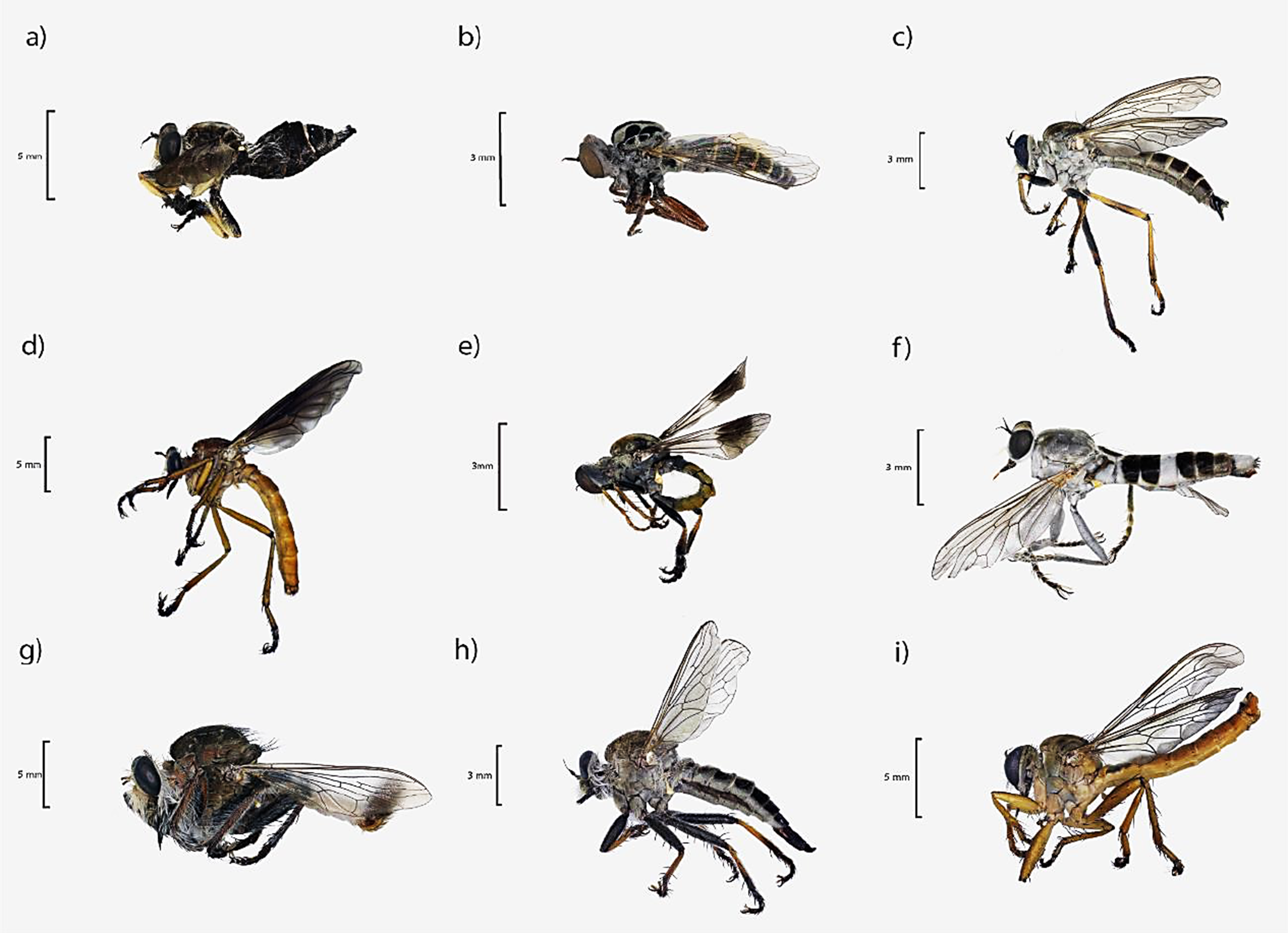
Figure 5 Asilidae specimens collected at “El Salado” in lateral view: a) Carreraomyia alpuyeca ♂, b) Itolia fascia ♀, c) Philonicus truquii ♂, d) Diogmites sallei ♀, e) Holopogon pulcher ♂, f) Stichopogon trifasciatus ♀, g) Efferia triton ♂, h) Efferia albibarbis ♀, i) Polacantha (E.) xanthocera ♂. All the photos taken by Bello-Morales.
We also recorded seven more species that were found during the samplings at the end of the rainy season (2014 and 2015) and that were not found in the other seasons. These data suggest that three samplings per year may not be enough to determine the real composition of robber fly communities. Thus, we suggest performing samplings at least every two months over the entire year in order to obtain more complete inventories; we also suggest conducting a different type of active sampling, such as direct sampling with an entomological net to decrease the bias of Malaise traps, which occurs because they are passive traps (McCravy & Baxa, 2011).
We thus conclude that the structure of the robber fly community is different between the dry and rainy seasons. Species richness and diversity were higher during the rainy season, abundance did not vary significantly, and species composition was different in each season.











 text new page (beta)
text new page (beta)

